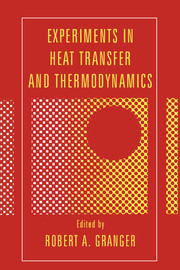Book contents
- Frontmatter
- Contents
- Preface
- Introduction
- Part I Experiments in heat transfer
- I.1 Conduction
- I.2 Convection
- I.3 Boiling
- I.4 Mixing, dispersion, and diffusion
- I.5 Radiation
- I.6 Heat pipes and exchangers
- Part II Experiments in thermodynamics
- Experiment 26 Effect of surface condition on attainable superheat of water
- Experiment 27 Experiments for compressibility and vapor pressure
- Experiment 28 Determination of time constants
- Experiment 29 Very fast versus very slow processes: Which are more efficient (closer to reversibility)?
- Experiment 30 Determination of volumetric fraction of each phase in multiphase flow
- Experiment 31 Measurement of the latent heat of vaporization of a liquid
- Experiment 32 Dilution techniques for the performance evaluation of continuous-flow combustion systems
- Appendix 1 Experiments and demonstrations in thermodynamics
- Appendix 2 Experiments and demonstrations in heat transfer
- Appendix 3 Heat-transfer and thermodynamic films
- Index
Experiment 29 - Very fast versus very slow processes: Which are more efficient (closer to reversibility)?
Published online by Cambridge University Press: 05 June 2012
- Frontmatter
- Contents
- Preface
- Introduction
- Part I Experiments in heat transfer
- I.1 Conduction
- I.2 Convection
- I.3 Boiling
- I.4 Mixing, dispersion, and diffusion
- I.5 Radiation
- I.6 Heat pipes and exchangers
- Part II Experiments in thermodynamics
- Experiment 26 Effect of surface condition on attainable superheat of water
- Experiment 27 Experiments for compressibility and vapor pressure
- Experiment 28 Determination of time constants
- Experiment 29 Very fast versus very slow processes: Which are more efficient (closer to reversibility)?
- Experiment 30 Determination of volumetric fraction of each phase in multiphase flow
- Experiment 31 Measurement of the latent heat of vaporization of a liquid
- Experiment 32 Dilution techniques for the performance evaluation of continuous-flow combustion systems
- Appendix 1 Experiments and demonstrations in thermodynamics
- Appendix 2 Experiments and demonstrations in heat transfer
- Appendix 3 Heat-transfer and thermodynamic films
- Index
Summary
Principle
Transfer of electricity out of a storage battery is much more efficient (closer to reversibility) when it is very fast rather than very slow.
Object
It is often argued that reversible processes take an infinite time to complete and, therefore, are of questionable usefulness. Although there is truth in this argument for certain processes, such as transfer of energy across a finite temperature difference, the argument is neither universally valid nor representative of some practical phenomena. A simple and very important counterexample is provided by a storage battery. If discharged quickly, the battery does work almost equal to the stored energy. If discharged more slowly than the rate of its internal discharge (let alone infinitely more slowly), the battery does practically no work, that is, all its availability is dissipated. The availability is dissipated because the internal discharge generates entropy spontaneously or, said differently, the internal discharge is irreversible.
Apparatus
As shown schematically in Fig. 29.1, the apparatus consists of a cell with two electrodes (1), a temperature bath (2), a glass thermometer and an electric heating plate (3), a galvanostat (4), a resistance box (5), an ammeter (6), and a voltmeter (7). Another schematic of the apparatus is shown in Fig. 29.2.
- Type
- Chapter
- Information
- Experiments in Heat Transfer and Thermodynamics , pp. 223 - 229Publisher: Cambridge University PressPrint publication year: 1994
- 1
- Cited by



